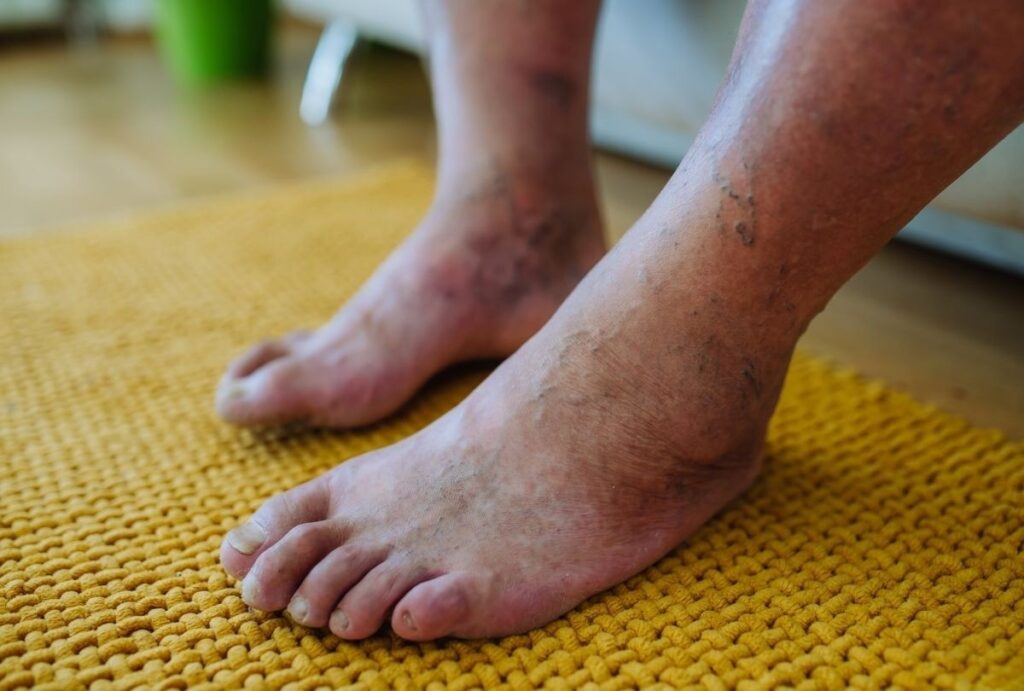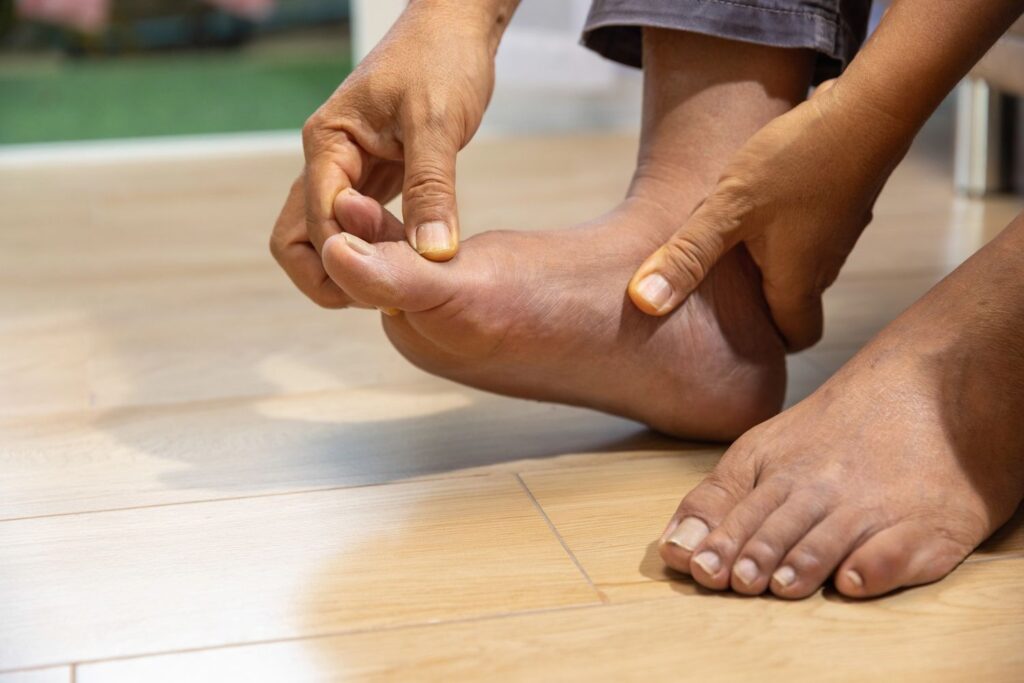Understanding Diabetic Foot Problems at a Glance
Diabetic foot issues don’t appear overnight. They build up quietly, often without clear warning. Many people don’t notice the early signs because the symptoms may look harmless at first—slightly dry skin, a tiny callus, a mild tingling sensation. But diabetes changes the way the body handles blood flow, nerves, healing, and infection. This combination creates the perfect storm for complications in the feet.
Spotting symptoms early gives you the biggest advantage. It helps prevent infections, ulcers, and amputations. The feet carry you throughout your life, so paying attention to the changes they show is more than routine—it’s survival.

How Diabetes Affects the Feet
Two Major Pathways That Trigger Diabetic Foot Problems
Diabetes affects the feet in two major ways. Together, these issues increase the risk of wounds, infections, deformities, and severe complications.
Nerve Damage (Diabetic Neuropathy)
High blood sugar slowly harms the nerves, especially in the hands and feet. Damaged nerves struggle to send signals, which affects sensation and movement. Many people lose the ability to feel pain, heat, or pressure.
Imagine stepping on a small stone and not even knowing it happened. This is how unnoticed injuries start.
Common nerve-related symptoms include:
- Complete or partial numbness
- Burning or stabbing pain
- Pins-and-needles sensations
- Weak muscle control
- Loss of balance
Poor Blood Flow (Peripheral Arterial Disease)
Diabetes also narrows the arteries. When blood flow slows down, the feet can’t receive the oxygen and nutrients they need. Even tiny wounds struggle to heal. This is why a small blister can turn into a deep ulcer.
Circulation-related symptoms include:
- Cramping when walking
- Cold feet
- Pain when resting
- Pale or bluish skin
Common Sensory Symptoms to Watch For
Numbness and Loss of Feeling
Numbness is one of the earliest and most dangerous symptoms. Many people describe it as a “blanket-like feeling” around the feet. They may not notice injuries, burns, cuts, or pressure spots.
When protective sensation is gone, every step becomes a risk.
Tingling, Burning, and Sharp Pains
Some individuals experience the opposite extreme—oversensitivity. The feet feel like they’re sparking, buzzing, or burning. These sensations flare up in the evening or while resting.
This nerve irritation can make walking uncomfortable and sleep difficult.
Visible Skin and Nail Changes
Dry, Cracked Skin and Thick Calluses
Diabetic neuropathy affects the way the skin produces oils. The feet dry out faster and cracks appear on the heels and sides. Calluses build up because the skin can’t regulate pressure properly.
Thick calluses signal high pressure areas. If ignored, they can hide underlying ulcers.
Blisters, Sores, and Ulcers That Don’t Heal
Slow-healing wounds are a classic diabetic foot symptom. Even minor injuries can become open sores and turn into ulcers.
Warning signs include:
- A shallow wound that doesn’t close
- A sore that leaks fluid
- A blister that becomes deeper instead of drying
These wounds can get infected easily, especially when sensation is reduced.
Discolored, Cold, or Shiny Skin
Changes in color or texture point to circulation issues.
Look for:
- Pale or bluish toes
- Shiny, tight-looking skin
- Cold areas around the toes or the entire foot
- Dark red spots
These symptoms indicate reduced blood flow or developing tissue damage.
Nail Changes and Fungal Infections
A diabetic foot often struggles with nail issues because blood circulation affects nail growth and infection control.
Common symptoms:
- Thick, brittle nails
- Yellow or dark discoloration
- Ingrown nails
- Fungal buildup
These nail problems can lead to skin injuries around the nail edges.
Redness, Swelling, Warmth, and Infection Warning Signs
Infection Symptoms That Need Urgent Attention
When infection sets in, the signs become more obvious.
Watch for:
- Warm areas on the foot
- Red streaks moving upward
- Pus or foul odor
- Swelling that doesn’t go away
- Fever or chills
An infected foot is a medical emergency. Delaying treatment may cause tissue death or bone infection.
Structural and Mechanical Changes in the Foot
Charcot Foot Deformity
Charcot foot is one of the most serious diabetic foot complications. It begins silently but progresses quickly.
Early signs include:
- Swelling
- Warmth
- A sudden change in shape
- Weak foot joints
When unnoticed, the bones collapse and the foot reshapes into a “rocker bottom” deformity. This condition makes walking difficult and drastically increases ulcer risk.
Changes in Gait, Shoe Fit, and Pressure Points
People with diabetic neuropathy often don’t walk the same way. The lack of sensation forces them to shift their weight awkwardly, creating new pressure points.
You may notice:
- Shoes fitting differently
- New calluses on unusual spots
- Uneven wear on slippers or shoes
These subtle changes can predict future ulcers.
Pain: What It Usually Means in Diabetic Foot Problems
Pain shows up in two key ways:
- Nerve pain — burning, shooting, stabbing, or electrical sensations
- Ischemic pain — pain due to lack of blood flow, especially at night or when legs are elevated
Many think that absence of pain is a good sign, but for diabetic feet, numbness is far riskier than pain.

Hidden Symptoms That People Often Ignore
Some diabetic foot symptoms don’t seem connected to the feet at all.
Common overlooked signs:
- Sudden loss of hair on the legs
- Cramping in the calves
- Weak pulse on the feet
- Feet feeling heavy
- New difficulties walking long distances
These early clues often show up before ulcers or infections.
When Symptoms Become a Red Flag
Seek urgent care when you experience:
- A wound that’s been open for more than 48 hours
- Increasing redness or warmth
- Black or dark patches
- Spreading swelling
- Fever with foot pain
Ignoring these signs can lead to amputation.
How Vital Podiatry Cypress Foot and Ankle Specialist Helps Patients
Expert Care for Diabetic Foot Symptoms
Vital Podiatry Cypress Foot and Ankle Specialist provides advanced diabetic foot care designed to prevent complications. Their team focuses on early detection, wound management, pressure relief, and long-term monitoring.
They offer:
- Comprehensive foot exams
- Nerve and circulation assessments
- Ulcer treatment
- Custom orthotics
- Guidance on daily foot care
Specialized care helps patients protect their feet and avoid severe outcomes.
Daily Habits That Protect You from Diabetic Foot Damage
Simple Steps You Can Start Today
Small habits create big protection.
Try these:
- Inspect your feet every day
- Keep the skin moisturized
- Choose well-fitting shoes
- Avoid walking barefoot
- Trim nails carefully
- Control blood sugar consistently
Consistent habits lower the risk of ulcers by keeping the skin, nerves, and circulation in better condition.
When to See a Foot Specialist
You need a foot specialist if you notice:
- New numbness
- Recurring blisters or calluses
- Changes in foot shape
- Skin color changes
- Wounds that heal slowly
A podiatrist can catch issues before they worsen.
Vital Podiatry Cypress Foot and Ankle Specialist Serving the Dominionat Copperfield Community and Beyond in Houston
Vital Podiatry Cypress Foot and Ankle Specialist is dedicated to serving the diverse needs of the local community of Houston, including individuals residing in neighborhoods like Dominionat Copperfield. With its convenient location near landmarks such as the Flaah Islamic Center and major intersections like Satsuma Station & Jackrabbit Rd. (coordinates: 29.912379369859217, -95.61878787704204), we offer diabetic foot care treatment Cypress services.
Get Diabetic Foot Care Treatment at Dominionat Copperfield Now
CALL US NOW!
(281) 937-4546
Navigate from Dominionat Copperfield to Vital Podiatry Cypress Foot and Ankle Specialist Now
Protecting Your Feet: The Critical Importance of Early Detection and Care
A diabetic foot doesn’t start with a dramatic symptom. It begins with small changes—dry skin, tingling, numbness, or a tiny blister. These symptoms deserve attention because they can grow into serious complications. Understanding what your feet are telling you helps you protect them for life.
Consistent monitoring, proper shoes, early treatment, and support from specialists like Vital Podiatry Cypress Foot and Ankle Specialist give you the strongest defense. When you pay attention to symptoms early, you preserve comfort, mobility, and long-term health.
FAQs
1. What is the earliest symptom of a diabetic foot?
Most people first experience numbness, tingling, or changes in skin dryness. These subtle signs often appear long before wounds or infections.
2. Do diabetic foot symptoms always include pain?
No. Many people feel no pain at all due to nerve damage. This is why diabetic foot problems can develop silently.
3. Why do diabetic foot wounds take so long to heal?
Poor circulation slows down tissue repair. High blood sugar also affects immune function, making it harder to fight infection.
4. When should I go to a podiatrist?
Seek help as soon as you see a wound, blister, color change, swelling, or unusual pain. Regular checkups are also recommended for preventive care.
5. How often should someone with diabetes check their feet?
A daily self-check is ideal. Look for cuts, swelling, discoloration, or changes in sensation.










